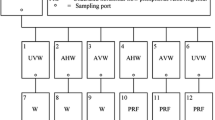Abstract
Water hyacinth (Eichhornia crassipes), duckweed (Spirodela sp. andLemna sp.), water pennywort (Hydrocotyle ranunculoides), and kudzu (Pueraria lobata) were anaerobically fermented using an anaerobic filter technique that reduced the total digestion time from 90 d to an average of 23 d and produced 0.14-0.22 m3 CH4/kg (dry weight) (2.3-3.6 ft3/lb) from mature filters for the 3 aquatic species. Kudzu required an average digestion time of 33 d and produced an average of 0.21 m3 CH4/kg (dry weight) (3.4 ft3/lb). The anaerobic filter provided a large surface area for the anaerobic bacteria to establish and maintain an optimal balance of facultative, acid-forming, and methane-producing bacteria. Consequently the efficiency of the process was greatly improved over prior batch fermentations.
Similar content being viewed by others
Literature Cited
Benemann, J. R. 1978. Bio-fuels: a survey. EPRI Report No. ER-746-SR. Electric Power Research Institute, Palo Alto, CA.
Boswell, A. M. 1947. Microbiology and theory of anaerobic digestion. Sewage Works J. 19: 28–35.
Genung, R. K., W. W. Pitt, Jr., G. M. Davis, and J. H. Koon. 1979. Energy conservation and scaleup studies for a wastewater treatment system based on a fixed-film, anaerobic bioreactor. Proc. Second Symposium on Bio-technology in Energy Production and Conservation.
Ghosh S., and D. L. Klass. 1976. SNG from refuse and sewage sludge by the biomass process. Proc. Clean Fuels from Biomass, Sewage, Urban Refuse, and Agricultural Wastes: 123-182.
—, and F. G. Pohland. 1974. Kinetics of substrate assimilation and product formation in anaerobic digestion. J. Water Pollut. Control Fed. 48: 748–759.
Johnson, A. L. 1977. Final report on research in methane generation. Aerospace Report No. ATR-77(9990)-4. El Segundo, CA.
Koon, J. H., G. M. Davis, R. K. Genung, and W. W. Pitt, Jr. 1979. The feasibility of an anaerobic upflow fixed-film process for treating small sewage flows. Proc. Energy Optimization of Water and Wastewater Management for Municipal and Industrial Applications.
McDonald, R. C., and B. C. Wolverton. 1980. Comparative study of wastewater lagoon with and without water hyacinth. Econ. Bot. 34: 101–110.
National Academy of Sciences. 1977. Methane generation from human, animal, and agricultural wastewater. Washington, DC.
Pohland, F. G., and S. Ghosh. 1971. Anaerobic stabilization of organic wastes—two-phase concept. Environ. Letters 1: 255–265.
Singh, R. B. 1971. Bio-gas plant, generating methane from organic wastes. Gobar Gas Research Station, Ajitmal, Etawah (U. P.), India.
Switzenbaum, M. S., and W. J. Jewell. 1978. Anaerobic attached film expanded bed reacter treatment of dilute organics. 51st Annual Water Pollut. Control Fed. Conf.
Wolverton, B. C. 1980. Unpublished data. Kudzu growth rate from March through June.
-, R. C. McDonald, and J. Gordon. 1975. Bio-conversion of water hyacinths into methane gas: part I. NASA Techn. Memorandum TM-X-72725.
—, and M. M. McKown. 1976. Water hyacinths for removal of phenols from polluted waters. Aquatic Bot. 2: 191–201.
-, and R. C. McDonald. 1977. Wastewater treatment utilizing water hyacinths (Eichhornia crassipes) (Mart.) Solms. Proc. 1977 National Conference on Treatment and Disposal of Industrial Wastewaters and Residues: 205-208.
—, and R. C. McDonald. 1979a. Water hyacinth (Eichhornia crassipes) productivity and harvesting studies. Econ. Bot. 33: 1–10.
—, and R. C. McDonald. 1979b. Upgrading facultative wastewater lagoons with vascular aquatic plants. J. Water Pollut. Control Fed. 51: 305–313.
—, and R. C. McDonald. 1979c. The water hyacinth: from prolific pest to potential provider. Ambio 8: 2–9.
Young, J. C, and P. L. McCarty. 1969. The anaerobic filter for waste treatment. J. Water Pollut. Control Fed. 41: 160–165.
Author information
Authors and Affiliations
Rights and permissions
About this article
Cite this article
Wolverton, B.C., Mcdonald, R.C. Energy from vascular plant wastewater treatment systems. Econ Bot 35, 224–232 (1981). https://doi.org/10.1007/BF02858689
Received:
Accepted:
Issue Date:
DOI: https://doi.org/10.1007/BF02858689




